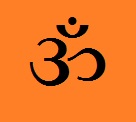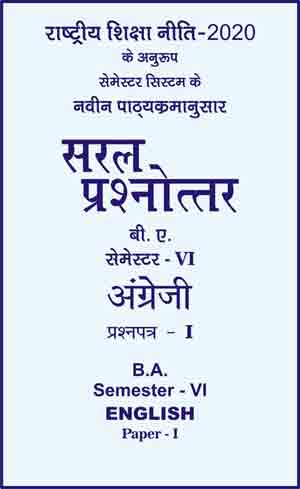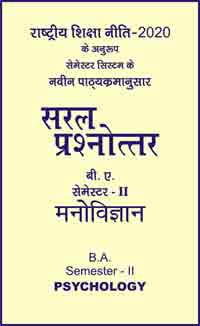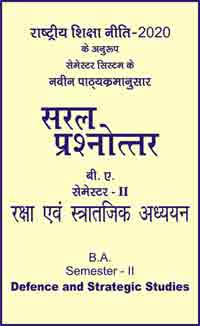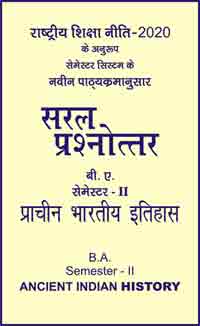|
बी ए - एम ए >> बीए सेमेस्टर 6 अंग्रेजी पेपर 1 बीए सेमेस्टर 6 अंग्रेजी पेपर 1सरल प्रश्नोत्तर समूह
|
5 पाठक हैं |
||||||
बीए सेमेस्टर 6 अंग्रेजी पेपर 1
Chapter 19 - Indira Goswami: The Moth Eaten Howdah of the Tusker
Objective Type Questions
For each of the following questions, four alternatives are given for the answer. Only one of them is correct. Choose the correct alternative.
-
Widowhood: Which character best represents the societal pressures faced by widows in the novel?
(a) Giribala
(b) Rajlakshmi
(c) Bimala
(d) Jamini -
Individuality: How does the Tusker symbolize liberation and freedom in the story?
(a) Through its wild and untamed nature
(b) By offering Giribala a means of escape
(c) As a symbol of rebellion against tradition
(d) All of the above -
Relationships: How does the power dynamic between men and women shift throughout the story?
(a) Women gradually gain a stronger voice and agency.
(b) The traditional patriarchal structure remains unshaken
(c) Men gradually lose their control over women
(d) The power dynamic fluctuates based on individual relationships. -
Symbolism: Which object or image symbolizes the burden of tradition in the novel?
(a) The moth-eaten howdah
(b) The dusty ancestral home
(c) The locked doors of the inner chambers
(d) The endless fields surrounding the village -
Internal Conflict: Which character faces an internal conflict in their pursuit of individuality?
(a) Indranath, torn between societal expectations and his love for Giribala
(b) Jamini, struggling to break free from the confines of her marriage
(c) Bimala, caught between her loyalty to family and her own desires
(d) All of the above -
Giribala: What motivates Giribala’s defiance against societal expectations?
(a) A deep-seated love for the Tusker
(b) A yearning for personal freedom and autonomy
(c) A desire to avenge the injustices faced by other women
(d) A combination of all of the above -
Indranath: How does Indranath’s perspective on life and society contrast with Giribala’s?
(a) He is more traditional and bound by societal norms
(b) He shares Giribala’s rebellious spirit and desire for change
(c) He is completely indifferent to the plight of women
(d) His views evolve throughout the story, influenced by Giribala -
Bimala: Which event or experience marks a turning point in Bimala’s character development?
(a) Witnessing Giribala’s interactions with the Tusker
(b) Her encounter with the traveling theater troupe
(c) The death of her mother
(d) Her defiance against her brother’s oppressive behavior -
Minor Character: Choose a minor character who plays a significant role in the story. How does this character contribute to the plot or thematic development?
(a) The Brahmin priest, enforcing the religious and social constraints
(b) The young boy, representing hope and a future free from tradition
(c) The old woman by the river, symbolizing wisdom and acceptance
(d) The traveling theater troupe, introducing an alternative viewpoint -
Imagery: Identify a specific image used in the novel and explain its significance.
(a) The description of the moth-eaten howdah, signifying decay and the burden of tradition
(b) The contrast between the lushness of nature and the rigidity of the ancestral home, highlighting the conflict between freedom and societal constraints
(c) The recurring image of the river, flowing and free, symbolizing the potential for escape and liberation
(d) The vivid portrayal of the Tusker’s movements, embodying power, wildness, and untamed spirit -
What is the primary theme of Indira Goswami’s The Moth Eaten Howdah of the Tusker?
(a) Adventure and Exploration
(b) Gender inequality and patriarchal norms
(c) Science and Technology
(d) Comedy and Satire -
Who is the protagonist of the novel?
(a) Mark Saheb
(b) Giribala
(c) Latu Goswami
(d) Indira Goswami -
What symbolizes the decay of patriarchal structures in the novel?
(a) A river
(b) The moth-eaten howdah
(c) A white saree
(d) A temple -
What societal expectation is highlighted through the treatment of widows in the novel?
(a) Financial independence
(b) Austerity and mourning
(c) Educational pursuits
(d) Artistic expression -
What does Giribala’s relationship with Mark Saheb symbolize?
(a) Traditional values
(b) Conflict between modernity and tradition
(c) Patriarchal approval
(d) Economic struggle -
What does the white saree worn by widows in the novel symbolize?
(a) Joy and freedom
(b) Loss of identity and societal restrictions
(c) Wealth and prosperity
(d) Professional success -
What aspect of society is critically portrayed in the novel?
(a) Technological advancements
(b) Patriarchal norms and gender roles
(c) Urban development
(d) Agricultural practices -
What does Giribala’s character primarily represent?
(a) A successful entrepreneur
(b) A woman’s struggle for identity in a patriarchal society
(c) A religious leader
(d) A political figure -
How is society portrayed in its treatment of Giribala’s husband’s infidelity?
(a) With severe punishment
(b) It is tacitly accepted
(c) He is excommunicated
(d) He is honored -
What does the novel suggest about traditional power structures?
(a) They are unchangeable
(b) They are strengthening
(c) They are declining
(d) They are irrelevant -
What is Giribala’s ultimate act of defiance?
(a) Starting a business
(b) Leaving her village
(c) Choosing death over a life of humiliation
(d) Becoming a political leader -
How does the novel reflect the inner world of an Indian woman?
(a) As fulfilled and content
(b) As conflicted and seeking freedom
(c) As politically active
(d) As focused on family only -
What traditional role of women is emphasized in the novel?
(a) Leaders and decision makers
(b) Educators and scholars
(c) Subservient and bound by societal norms
(d) Entrepreneurs and innovators -
What does the act of Giribala helping Mark Saheb in his research signify?
(a) Economic development
(b) Her intellectual curiosity and defiance of traditional roles
(c) Her desire to travel
(d) A love for history -
What does the burning shed symbolize in Giribala’s tragic end?
(a) Rebirth and renewal
(b) The destructive nature of traditional norms
(c) A celebration of her life
(d) The strength of the community -
What does the novel reveal about the status of women in Brahmin society?
(a) They are revered and respected
(b) They are equal to men
(c) They are suppressed and marginalized
(d) They are financially independent -
What role does the character of Indranath play in the novel?
(a) Antagonist
(b) Comic relief
(c) The main protagonist
(d) A supportive character -
What issue apart from gender inequality is highlighted in the novel?
(a) Environmental conservation
(b) Drug addiction
(c) Political corruption
(d) Technological advancement -
How is the sociopolitical scenario of post-independence India portrayed in the novel?
(a) Optimistic and progressive
(b) Chaotic and transitional
(c) Stable and prosperous
(d) Unchanged and static -
What does the novel illustrate about the impact of societal norms on personal relationships?
(a) They enhance personal relationships
(b) They have no impact on personal relationships
(c) They complicate and often damage personal relationships
(d) They are irrelevant to personal relationships -
How is the Satra depicted in the novel?
(a) As a place of technological innovation
(b) As a center of political power
(c) As a symbol of tradition and conservatism
(d) As a hub of economic activity -
What does the character of Durga in the novel symbolize?
(a) Women’s liberation
(b) The tragic oppression of widows
(c) Financial independence
(d) Political activism -
What aspect of Brahmin society is critiqued through the character of Shoru Goshani?
(a) Entrepreneurial spirit
(b) Educational systems
(c) Social bandages and regulations
(d) Technological advancements -
What is a significant feature of Goswami’s writing style in the novel?
(a) Use of futuristic themes
(b) Emphasis on economic theories
(c) Emotionalism and picturism
(d) Focus on scientific accuracy -
What does the novel’s ending with the deaths of key characters symbolize?
(a) The triumph of traditional values
(b) The resilience of human spirit
(c) The downfall of aristocratic families and old norms
(d) The unchanging nature of society -
This novel 'The Moth Eaten Howdah of the Tusker' ends with -
(a) The death of the Tusker
(b) Giribala's suicide
(c) Indranath's tragic death
(d) All of the above -
What is the pen name of Indira Goswami?
(a) Mohini Rai Goswami
(b) Mamoni Raisom Goswami
(c) Mahi Rahi Goswami
(d) Memna Raisom Goswami -
Where was Indira Goswami born?
(a) Mumbai
(b) Delhi
(c) Guwahati
(d) Gwalior -
What is the name of the father of Indira Goswami?
(a) Ramakant Goswami
(b) Umakant Goswami
(c) Rajaram Goswami
(d) Rajesh Goswami -
Who was the mother of Indira Goswami?
(a) Radha Devi
(b) Shobha Devi
(c) Ambika Devi
(d) Geeta Devi -
Indira Goswami belongs to -
(a) A Vaishnavite Brahmin Family
(b) A Kshatriya Family
(c) A Vaishya Family
(d) Lower family -
What was the name of the first collection of short stories?
(a) Monkey Moron - a teacher
(b) Chinaki Moron - a student
(c) Pinaki Maron - a Professor
(d) None of these -
Indira Goswami received the Sahitya Academy Award for Mamore Dhora Tarowal in -
(a) 1980
(b) 1983
(c) 1987
(d) 1990 -
In 1983, Indira Goswami received which award?
(a) Sahitya Akademi Award
(b) Katha National Award for Literature
(c) Jnanpith Award
(d) All of the above -
Indira Goswami received the Jnanpith Award in -
(a) 2000
(b) 2001
(c) 2002
(d) 2004 -
Which was the highest civilian award in the state of Assam?
(a) Asom Ratna
(b) Wisom Ratna
(c) Padma Ratna
(d) Rashmi Ratna -
The Moth Eaten Howdah of the Tusker is written by -
(a) Judith Wright
(b) Indira Goswami
(c) Patrick White
(d) Kamala Das -
The Moth Eaten Howdah of the Tusker was published as Dontal Hatir Une Know a Howdah in -
(a) 1980
(b) 1986
(c) 1990
(d) 1992 -
This novel 'The Moth Eaten Howdah of the Tusker' was translated into English in -
(a) 2001
(b) 2004
(c) 2006
(d) 2014 -
In The Moth Eaten Howdah of the Tusker, which dialect is used by the author?
(a) Rampuri dialect
(b) Kamrupi dialect
(c) Russian dialect
(d) Kanpuria dialect -
This novel The Moth Eaten Howdah of the Tusker is set in -
(a) Palasia in Indore
(b) Palashbari in Karump
(c) Patankhet
(d) Bharatpur in Rajasthan -
Which is the character of The Moth Eaten Howdah of the Tusker?
(a) Indranath
(b) Giribala
(c) Durga
(d) All of the above -
Who was the sister of Indranath?
(a) Durga
(b) Giribala
(c) Illimon
(d) None of these -
Who was the intelligent character in The Moth Eaten Howdah of the Tusker?
(a) Indranath
(b) Durga
(c) Illimon
(d) Giribala -
The novel The Moth Eaten Howdah of the Tusker is a -
(a) Comic Story
(b) Tragic Story
(c) Homible Story
(d) Mystic Story -
Who is Saru Gushani in The Moth Eaten Howdah of the Tusker?
(a) Indranath's aunt
(b) Durga's aunt
(c) A Sycophant
(d) A Servant -
Who is Durga in The Moth Eaten Howdah of the Tusker?
(a) Indranath's father's Sister
(b) Mother of Giribala
(c) Illimon's sister
(d) Mother of Saru Gushani -
Who is Jagannath in The Moth Eaten Howdah of the Tusker?
(a) The Elephant
(b) A Lion
(c) The Dog
(d) An Ass
|
|||||




